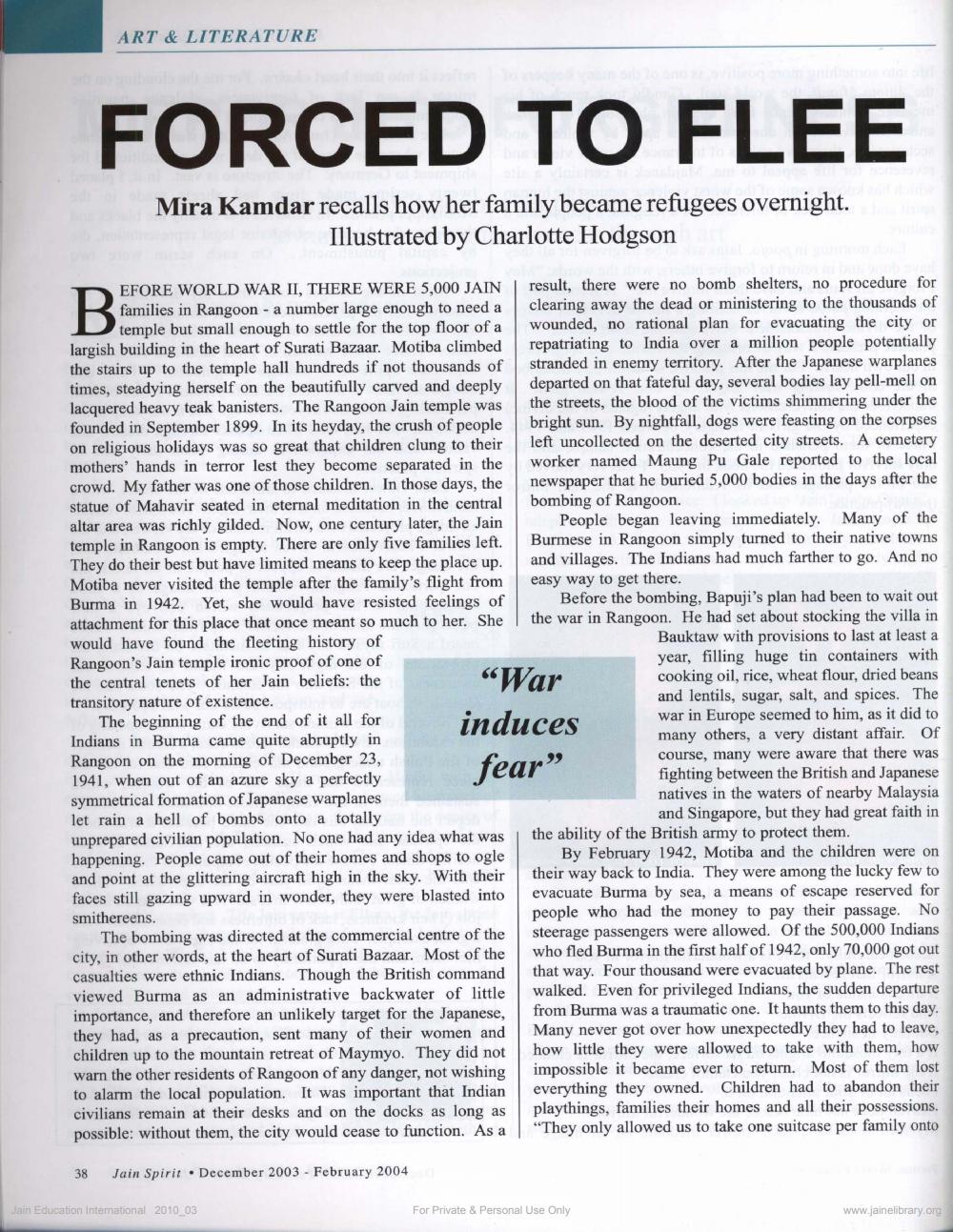________________
ART & LITERATURE
FORCED TO FLEE
Mira Kamdar recalls how her family became refugees overnight. Illustrated by Charlotte Hodgson
B
EFORE WORLD WAR II, THERE WERE 5,000 JAIN families in Rangoon - a number large enough to need a temple but small enough to settle for the top floor of a largish building in the heart of Surati Bazaar. Motiba climbed the stairs up to the temple hall hundreds if not thousands of times, steadying herself on the beautifully carved and deeply lacquered heavy teak banisters. The Rangoon Jain temple was founded in September 1899. In its heyday, the crush of people on religious holidays was so great that children clung to their mothers' hands in terror lest they become separated in the crowd. My father was one of those children. In those days, the statue of Mahavir seated in eternal meditation in the central altar area was richly gilded. Now, one century later, the Jain temple in Rangoon is empty. There are only five families left. They do their best but have limited means to keep the place up. Motiba never visited the temple after the family's flight from Burma in 1942. Yet, she would have resisted feelings of attachment for this place that once meant so much to her. She would have found the fleeting history of Rangoon's Jain temple ironic proof of one of the central tenets of her Jain beliefs: the transitory nature of existence.
The beginning of the end of it all for Indians in Burma came quite abruptly in Rangoon on the morning of December 23, 1941, when out of an azure sky a perfectly symmetrical formation of Japanese warplanes let rain a hell of bombs onto a totally unprepared civilian population. No one had any idea what was happening. People came out of their homes and shops to ogle and point at the glittering aircraft high in the sky. With their faces still gazing upward in wonder, they were blasted into smithereens.
38
The bombing was directed at the commercial centre of the city, in other words, at the heart of Surati Bazaar. Most of the casualties were ethnic Indians. Though the British command viewed Burma as an administrative backwater of little importance, and therefore an unlikely target for the Japanese, they had, as a precaution, sent many of their women and children up to the mountain retreat of Maymyo. They did not warn the other residents of Rangoon of any danger, not wishing to alarm the local population. It was important that Indian civilians remain at their desks and on the docks as long as possible: without them, the city would cease to function. As a
Jain Spirit December 2003 February 2004.
Jain Education International 2010_03
result, there were no bomb shelters, no procedure for clearing away the dead or ministering to the thousands of wounded, no rational plan for evacuating the city or repatriating to India over a million people potentially stranded in enemy territory. After the Japanese warplanes departed on that fateful day, several bodies lay pell-mell on the streets, the blood of the victims shimmering under the bright sun. By nightfall, dogs were feasting on the corpses left uncollected on the deserted city streets. A cemetery worker named Maung Pu Gale reported to the local newspaper that he buried 5,000 bodies in the days after the bombing of Rangoon,
People began leaving immediately. Many of the Burmese in Rangoon simply turned to their native towns and villages. The Indians had much farther to go. And no easy way to get there.
Before the bombing, Bapuji's plan had been to wait out the war in Rangoon. He had set about stocking the villa in Bauktaw with provisions to last at least a year, filling huge tin containers with cooking oil, rice, wheat flour, dried beans and lentils, sugar, salt, and spices. The war in Europe seemed to him, as it did to many others, a very distant affair. Of course, many were aware that there was fighting between the British and Japanese natives in the waters of nearby Malaysia and Singapore, but they had great faith in the ability of the British army to protect them.
By February 1942, Motiba and the children were on their way back to India. They were among the lucky few to evacuate Burma by sea, a means of escape reserved for people who had the money to pay their passage. No steerage passengers were allowed. Of the 500,000 Indians who fled Burma in the first half of 1942, only 70,000 got out that way. Four thousand were evacuated by plane. The rest walked. Even for privileged Indians, the sudden departure from Burma was a traumatic one. It haunts them to this day. Many never got over how unexpectedly they had to leave, how little they were allowed to take with them, how impossible it became ever to return. Most of them lost everything they owned. Children had to abandon their playthings, families their homes and all their possessions. "They only allowed us to take one suitcase per family onto
"War induces fear"
For Private & Personal Use Only
www.jainelibrary.org




